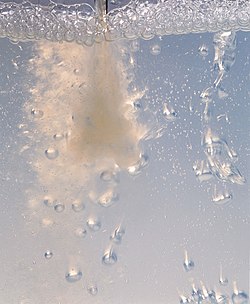The Importance of Chemical Defoamer in Sewage Management
The Value of Making Use Of a Chemical Defoamer in Numerous Applications
The application of chemical defoamers is a necessary factor to consider across numerous markets, consisting of food processing, wastewater treatment, and drugs. These agents play a crucial function in mitigating foam formation, which can impede performance and concession product quality. The advantages of utilizing defoamers extend past mere appearances; they are critical for achieving conformity with sector standards and enhancing operational processes. However, the devices by which defoamers function and their particular applications increase better inquiries about their overall impact and effectiveness in these varied contexts. What understandings can be discovered regarding their usage?
Comprehending Foam Formation
Foam formation is a complicated physical sensation that happens when gas bubbles are trapped within a liquid matrix, leading to the production of a steady framework. This procedure can be influenced by different variables, consisting of the viscosity of the liquid, the surface area tension at the gas-liquid user interface, and the existence of surfactants. Surfactants reduced the surface area tension, advertising bubble development and stablizing, which usually brings about the development of foam in many industrial processes.
Foams are generally experienced in applications such as food production, wastewater treatment, and chemical manufacturing. In these contexts, foam can function as an insulator, disrupt blending processes, or impede the effectiveness of tools. The security of foam is figured out by the balance between the forces acting to support the bubbles and those that advertise their collapse.
Understanding the technicians of foam development is essential for successfully managing its presence in different systems. By understanding the underlying principles, sectors can design approaches to alleviate undesirable lathering, consequently boosting operational efficiency and product top quality. This fundamental expertise works as a precursor to checking out the energy of chemical defoamers, which specifically attend to foam-related obstacles in many applications.
Advantages of Chemical Defoamers
Chemical defoamers provide considerable benefits across numerous sectors by efficiently regulating and minimizing foam development. By reducing foam, chemical defoamers aid keep optimum production prices and reduce downtime connected with foam monitoring.
In addition, chemical defoamers add to enhanced product top quality. Lathering often leads to inconsistencies in formulations, which can adversely impact the final item. By managing foam levels, defoamers ensure harmony, therefore enhancing the overall high quality of the outcome.
Cost-effectiveness is one more noteworthy advantage (Chemical Defoamer). By reducing the amount of resources needed for production and minimizing waste, chemical defoamers can result in significant savings. They usually permit for decreased energy intake, as procedures can run a lot more efficiently and need much less treatment.
Applications in Food Handling
In the food handling sector, reliable monitoring of foam is vital to ensure both product quality and functional effectiveness. Foam can disrupt different processes, from mixing and blending to packaging, leading to minimized yields and prospective contamination. Chemical defoamers play an essential function in alleviating these problems by quickly damaging down foam, permitting smoother procedures and enhanced product uniformity.
In applications such as dairy products processing, defoamers stop excess foam development throughout the production of milk, yogurt, and cheese, which can interrupt machinery and influence the structure of the end product. In developing and fermentation procedures, foam control is vital to keep the stability of the drink and guarantee ideal fermentation prices.
In addition, chemical defoamers are used in food dressings, sauces, and solutions to enhance the security and appearance of the last items. By lessening foam during manufacturing, makers can accomplish much better mixing and dispersion of ingredients, leading to exceptional top quality. In general, the consolidation of chemical defoamers in food handling is crucial for maintaining efficiency, quality, and security in food manufacturing.
Function in Wastewater Treatment
Efficient foam administration is equally important in wastewater treatment procedures, where too much foam can prevent procedures and complicate the therapy of effluents. In numerous wastewater therapy centers, foam can create as an outcome of biological activity, surfactants, or other organic materials present in the influent. This foam can lead to a range of operational difficulties, including reduced therapy efficiency, enhanced maintenance needs, and site web possible regulative compliance issues.
Chemical defoamers play an essential role in minimizing these obstacles. By minimizing the surface stress of the liquid, defoamers promote the collapse of foam structures, hence assisting in smoother procedure of equipment such as oygenation storage tanks and clarifiers. Their prompt application assists keep ideal hydraulic problems, boosting the total effectiveness of solids separation procedures.

Impact on Pharmaceutical Production
Foam control is essential in pharmaceutical manufacturing, where the existence of extreme foam can interrupt producing processes and compromise product top quality (Chemical Defoamer). The development of foam throughout different stages, click here to read such as blending, mixing, and fermentation, can bring about ineffective mixing, insufficient heat transfer, and even devices damage. These issues not just cause functional delays yet can additionally create considerable monetary losses and affect compliance with stringent regulatory standards
Chemical defoamers are especially created to alleviate these difficulties. By properly lowering foam formation, they improve procedure performance and maintain the honesty of the end product. In certain, defoamers ensure constant dose forms, boost the stability of suspensions and solutions, and streamline cleansing processes by preventing foam accumulation in equipment.
In addition, making use of defoamers can enhance the yield of energetic pharmaceutical components (APIs) by advertising much better removal and purification processes. As pharmaceutical business make every effort to improve product quality while decreasing manufacturing expenses, the function of chemical defoamers becomes progressively important - Chemical Defoamer. Their unification into producing protocols not just supports conformity with Great Production Practices (GMP) but additionally promotes innovation and competition in a rapidly progressing industry

Verdict

Chemical defoamers provide significant benefits across different industries by successfully managing and reducing foam formation. By decreasing foam, chemical defoamers assist keep optimum manufacturing rates and minimize downtime linked with foam monitoring. Chemical defoamers play an essential function in reducing these concerns by quickly breaking down foam, permitting for smoother operations and improved item consistency.
Efficient foam monitoring is equally crucial in wastewater therapy processes, where too much foam can hinder operations and make complex the therapy of effluents.Foam control is essential in pharmaceutical manufacturing, where the visibility of excessive foam can interrupt making procedures and compromise product quality.